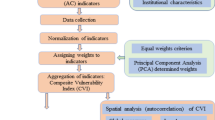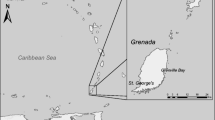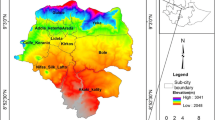Abstract
The impacts of climate change are of particular concern to the coastal region of tropical countries like India, which are exposed to cyclones, floods, tsunami, seawater intrusion, etc. Climate-change adaptation presupposes comprehensive assessment of vulnerability status. Studies so far relied either on remote sensing-based spatial mapping of physical vulnerability or on certain socio-economic aspects with limited scope for upscaling or replication. The current study is an attempt to develop a holistic and robust framework to assess the vulnerability of coastal India at different levels. We propose and estimate cumulative vulnerability index (CVI) as a function of exposure, sensitivity and adaptive capacity, at the village level, using nationally comparable and credible datasets. The exposure index (EI) was determined at the village level by decomposing the spatial multi-hazard maps, while sensitivity (SI) and adaptive capacity indices (ACI) were estimated using 23 indicators, covering social and economic aspects. The indicators were identified through the literature review, expert consultations, opinion survey, and were further validated through statistical tests. The socio-economic vulnerability index (SEVI) was constructed as a function of sensitivity and adaptive capacity for planning grassroot-level interventions and adaptation strategies. The framework was piloted in Sindhudurg, a coastal district in Maharashtra, India. It comprises 317 villages, spread across three taluks viz., Devgad, Malvan and Vengurla. The villages in Sindhudurg were ranked based on this multi-criteria approach. Based on CVI values, 92 villages (30%) in Sindhudurg were identified as highly vulnerable. We propose a decision tool for identifying villages vulnerable to changing climate, based on their level of sensitivity and adaptive capacity in a two-dimensional matrix, thus aiding in planning location-specific interventions. Here, vulnerability indicators are classified and designated as ‘drivers’ (indicators with significantly high values and intervention priority) and ‘buffers’ (indicators with low-to-moderate values) at the village level. The framework provides for aggregation or decomposition of CVI and other sub-indices, in order to plan spatial contingency plans and enable swift action for climate adaptation.









Similar content being viewed by others
References
Adger, W.N. 1999. Social Vulnerability to Climate Change and Extremes in Coastal Vietnam. World Development 27: 249–269.
Adger, W.N., and P.M. Kelly. 1999. Social vulnerability to climate change and the architecture of entitlements. Mitigation and Adaptation Strategies for Global Change 4: 253–266.
Ahsan, N.Md., and W. Jeroen. 2014. The socioeconomic vulnerability index: A pragmatic approach for assessing climate change led risks—A case study in the south-western coastal Bangladesh. International Journal of Disaster Risk Reduction 8: 32–49.
Amadore, L., W.C. Bolhofer, R.V. Cruz, R.B. Feir, C.A. Freysinger, S. Guill, K.F. Jalal, A. Iglesias, et al. 1996. Climate change vulnerability and adaptation in Asia and the Pacific: Workshop Summary. Water, Air, and Soil Pollution 94: 1–12.
Babanrao, N.D. 2011. Cashew cultivation in south Konkan of Maharashtra: A geographical analysis. PhD Thesis, Shivaju University, Kolhapur.
Blaikie, P., T. Cannon, I. Davis, and B. Wisner. 1994. At Risk: Natural Hazards, People’s Vulnerability, and Disasters. London: Routledge.
Bos, M.G., H. Van den Bosch, H. Diemont, H. Van Keulen, J. Lahr, G. Meijerink, and A. Verhagen. 2007. Quantifying the sustainability of agriculture. Irrigation and Drainage Systems 21: 1–15.
Central Intelligence Agency. 2018. The World Factbook 2018. Washington, DC: Central Intelligence Agency. https://www.cia.gov/library/publications/the-world-factbook/fields/2060.html. Accessed 8 September 2017.
Chandrasekar, N., V. Joevivek, and S. Saravanan. 2013. Coastal vulnerability and shoreline changes for southern tip of India—Remote sensing and GIS approach. Journal of Earth Science and Climate Change 4: 144.
CMIS Online. 2017. Coastal Mgmt Info System. https://mahammb.maharashtra.gov.in/1155/Geographic-Information-System-Portal. Accessed 2 Aug 2017.
Cronbach, L.J. 1951. Coefficient alpha and the internal structure of tests. Psychometrika 16: 297–334.
Cross, J.A. 2001. Megacities and small towns: Different perspectives on hazard vulnerability. Environmental Hazards 3: 63–80.
Cutter, S.L., B.J. Boruff, and W.L. Shirley. 2003. Social vulnerability to environmental hazards. Social Science Quarterly 84: 242–261.
Dale, V.H., and S.C. Beyeler. 2001. Challenges in the development and use of ecological indicators. Ecological Indicators 1: 3–10.
Dube, S.K., I. Jain, A.D. Rao, and T.S. Murty. 2009. Storm surge modelling for the Bay of Bengal and Arabian Sea. Natural Hazards 51: 3–27.
Dwarakish, G.S., S.A. Vinay, U. Natesan, T. Asano, T. Kakinuma, K. Venkataraman, J. Pai, and M.K. Babita. 2009. Coastal vulnerability assessment of the future sea level rise in Udupi Coastal Zone of Karnataka State, west coast of India. Ocean and Coastal Management 52: 467–478.
Esteves, T., D. Ravindranath, S. Beddamatta, K.V. Raju, J. Sharma, G. Bala, and I.K. Murthy. 2016. Multi-scale vulnerability assessment for adaptation planning. Current Science 110: 1225–1239.
Eguiguren-Velepucha, P.A., J.A.M. Chamba, N.A.A. Mendoza, T.L. Ojeda-Luna, N.S. Samaniego-Rojas, M.J. Furniss, C. Howe, and Z.H.A. Mendoza. 2016. Tropical ecosystems vulnerability to climate change in southern Ecuador. In Tropical Conservation Science, 1–17.
Fekete, A. 2009. Validation of a social vulnerability index in context to river-floods in Germany. Natural Hazards and Earth System Sciences 9: 393–403.
Ge, Y., W. Dou, Z. Gu, X. Qian, J. Wang, W. Xu, P. Shi, X. Ming, et al. 2013. Assessment of social vulnerability to natural hazards in the Yangtze River Delta, China. Stochastic Environmental Research and Risk Assessment 27: 1899–1908.
Gibbons, J.D., and S. Chakraborti. 2003. Nonparametric statistical inference. New York: Marcel Dekker, Inc.
Gómez-Limón, J.A., and G. Sanchez-Fernandez. 2010. Empirical evaluation of agricultural sustainability using composite indicators. Ecological Economics 69: 1062–1075.
Goswami, R. 2011. What Census 2011 reveals about our growers and their land. http://www.macroscan.org/anl/jun13/Census_2011.pdf. Accessed 22 July 2017.
Hegde, A.V., and V.R. Reju. 2007. Development of coastal vulnerability index for Mangalore Coast, India. Journal of Coastal Research 23: 1106–1111.
Hwang, C., and K. Yoon. 1981. Multiple attribute decision making: Methods and Applications a state-of-the-art survey. Berlin: Springer.
ICOR. 2015. Report on the conference on climate change, coastal ecology and fisheries resources and livelihood in Maharashtra. Mumbai: Institute of Community Organisation Research.
INCCA. 2010. Climate change and India: A 4 × 4 Assessment—A sectoral and regional analysis for 2030s. INCCA: Indian Network for Climate Change Assessment, Ministry of Environment and Forests, Government of India.
INCOIS. 2012. Coastal vulnerability Atlas of India. Hyderabad: Indian National Centre for Ocean Information Services.
IPCC. 2007. Climate change (2007): Impacts, adaptation and vulnerability. Contribution of Working Group II to the Fourth Assessment Report of the Intergovernmental Panel on Climate Change. Cambridge: Cambridge University Press.
IPCC. 2014. Climate change 2014: Impacts, adaptation and vulnerability. Part A: Global and sectoral aspects. Contribution of Working Groups I and II of the Intergovernmental Panel on Climate Change. Cambridge: Cambridge University Press.
Kumar, K.K.S., R.J.T. Klein, C. Ionescu, J. Hinkel, and R. Klein. 2007. Vulnerability to poverty and vulnerability to climate change: Conceptual framework, measurement and synergies in policy. Working Paper 19/2007. Chennai: Madras School of Economics.
Kumar, K.K., S.K. Patwardhan, A. Kulkarni, K. Kamala, K.K. Rao, and R. Jones. 2011. Simulated projections for summer monsoon climate over India by a high-resolution regional climate model (PRECIS). Current Science 101: 312–326.
Lee, Y.J. 2014. Social vulnerability indicators as a sustainable planning tool. Environment Impact Assessment Review 44: 31–42.
Lee, J.R., R. Maggini, M.F.J. Taylor, and R.A. Fuller. 2015. Mapping the drivers of climate change vulnerability for Australia’s threatened species. PLoS ONE. https://doi.org/10.1371/journal.pone.0124766.
Li, X., J. Philp, R. Cremades, A. Roberts, L. He, L. Li, and Q. Yu. 2015. Agricultural vulnerability over the Chinese Loess Plateau in response to climate change: Exposure, sensitivity, and adaptive capacity. Ambio 45: 350–360. https://doi.org/10.1007/s13280-015-0727-8.
Livestock Census. 2012. Report on 19th Livestock Census-2012. Commissionerate of Animal Husbandry. http://farmer.gov.in/livestockcensus.aspx?Scode=11. Accessed 18 May 2017.
Long, S.J. 1983. Confirmatory factor analysis: A preface to LISREL. Sage University Paper series on quantitative applications in the social sciences, series no. 07-033. Thousand Oaks, CA: Sage Publications, Inc.
Mahendra, R.S., P.C. Mohanty, S.T. Kumar, S.S.C. Shenoi, and S. Nayak. 2010. Coastal multi-hazard vulnerability mapping: A case study along the Coast of the Nellore District, Andhra Pradesh, East Coast of India. Italian Journal of Remote Sensing 42: 67–76.
Mahendra, R.S., P.C. Mohanty, H. Bisoyi, S.T. Kumar, and S. Nayak. 2011. Assessment and management of coastal multi-hazard vulnerability along the Cuddalore–Villupuram, East Coast of India using geospatial techniques. Ocean and Coastal Management 54: 302–311.
Maiti, S., S.K. Jha, S. Garai, A. Nag, R. Chakravarty, K.S. Kadian, B.S. Chandel, K.K. Datta, et al. 2015. Assessment of social vulnerability to climate change in the eastern coast of India. Climatic Change 131: 287–306.
Marine Fisheries Census. 2010. Marine Fisheries Census 2010: Maharashtra. Part II (9). Kochi: Central Marine Fisheries Research Institute.
Mayer, D.G., and D.G. Butler. 1993. Statistical validation. Ecological Modelling 68: 21–32.
McCarthy, J.J., O.F. Canziani, N.A. Leary, D.J. Dokken, and K.S. White. 2001. Climate change 2001: Impacts, adaptation, and vulnerability. Cambridge: Cambridge University Press.
Moss, R.H., A.L. Brenkert, and E.L. Malone. 2001. Vulnerability to climate change: A quantitative approach. Oak Ridge: United States Department of Energy under Contract DE-AC06-76RLO 1830.
Murali, R.M., M. Ankita, S. Amrita, and P. Vethamony. 2013. Coastal vulnerability assessment of Puducherry Coast, India, using analytical hierarchical process. Natural Hazards and Earth System Sciences 13: 3291–3311.
NCM. 2016. National Coastal Mission. New Delhi: Ministry of Environment, Forest and Climate Change, Government of India.
Nijkamp, P., P. Rietveld, and H. Voogd. 1990. Multicriteria evaluation in physical planning. Amsterdam: Elsevier Science Publishers B.V.
NASA METI. 2011. Routine ASTER global digital elevation model. NASA EOSDIS Land Processes DAAC. https://doi.org/10.5067/aster/astgtm.002.
NASA JPL. 2013. NASA Shuttle Radar Topography Mission Global 1 arc second (Data set). NASA EOSDIS Land Processes DAAC. https://doi.org/10.5067/measures/srtm/srtmgl1.003.
Office of the Registrar General and Census Commissioner, India. 2001. Census of India. Office of the Registrar General and Census Commissioner, India, Ministry of Home Affairs, Government of India.
Office of the Registrar General and Census Commissioner, India. 2011. Census of India. Office of the Registrar General and Census Commissioner, India, Ministry of Home Affairs, Government of India.
NRSC. 2011. Space based information support for decentralized planning (SIS-DP): Preparation of geo spatial layers using high resolution (Cartosat-1 Pan + LISS-IVMx) orthorectified satellite imagery, remote sensing and GIS applications area. Hyderabad: National Remote Sensing Centre, Indian Space Research Organisation (ISRO), Department of Space, Government of India.
NRSC. 2014. CartoDEM: A national digital elevation model from Cartosat 1 stereo data. Hyderabad: National Remote Sensing Centre, Indian Space Research Organisation (ISRO), Department of Space, Government of India. http://www.http://bhuvan.nrsc.gov.in/data/download/tools/document/cartodem_bro_final.pdf. Accessed 7 Sep 2017.
O’Brien, K., S. Eriksen, A. Schjolden, and L.P. Nygaard. 2004. What’s in a word? Conflicting interpretations of vulnerability in climate change research. CICERO Working Paper 2004:04. Oslo: Centre for International Climate and Environmental Research.
Ojwang’, G.O., J. Agatsiva, and C. Situma. 2010. Analysis of climate change and variability risks in the smallholder sector: Case studies of the Laikipia and Narok Districts representing major agro-ecological zones in Kenya. Rome: Food and Agriculture Organization of the United Nations.
Palanisami, K., C. Ranganathan, S. Senthilnathan, and C. Umetsu. 2008. Developing the composite vulnerability index relating to climate change for the different agro climatic regions of Tamilnadu. FY2007 FR1 Project Report. Inter-University Research Institute Corporation, National Institutes for the Humanities, Research Institute for Humanity and Nature, Japan.
Patnaik, U., and K. Narayanan. 2009. Vulnerability and climate change: An analysis of the eastern coastal districts of India. Paper No. 22062. Munich Personal RePEc Archive, Germany.
Pelling, M., and J.I. Uitto. 2001. Small island developing states: Natural disaster vulnerability and global change. Environmental Hazards 3: 49–62.
Planning Commission. 2005. Mid-term Appraisal of the Tenth Five Year Plan (2002–2007). New Delhi: Government of India. http://planningcommission.nic.in/plans/mta/midterm/english-pdf/chapter-17.pdf. Accessed 22 September 2017.
Ramasubramanian, V., A. Kumar, P. Bishop, P. Ramasundaram, and C.J. Jeeva. 2014. Applications of quantitative techniques in technology forecasting: Some case studies. In Role of applied statistics in forestry research, ed. H. Chandra, and G. Chandra. Dehradun: Indian Council of Forestry Research and Education.
Rani, S.N.N.V., A.N.V. Satyanarayana, and P.K. Bhaskaran. 2015. Coastal vulnerability assessment studies over India: A review. Natural Hazards 77: 405–428.
Rao, R.C.A., B.M.K. Raju, S.A.V.M. Rao, K.V. Rao, V.U.M. Rao, K. Ramachandran, B. Venkateswarlu, and A.K. Sikka. 2013. Atlas on vulnerability of Indian agriculture to climate change. Hyderabad: Central Research Institute for Dryland Agriculture.
Rao, N.K., P. Subraelu, V.T. Rao, B.H. Malini, R. Ratheesh, S. Bhattacharya, and A.S. Rajawat. 2009. Sea-level rise and coastal vulnerability: An assessment of Andhra Pradesh Coast, India through remote sensing and GIS. Journal of Coastal Conservation 12: 195–207.
Ravindranath, N.H., S. Rao, N. Sharma, M. Nair, R. Gopalakrishnan, A.S. Rao, S. Malaviya, R. Tiwari, et al. 2011. Climate change vulnerability profiles for North East India. Current Science 101: 384–394.
Rodríguez, E., C.S. Morris, and J.E. Belz. 2006. A global assessment of the SRTM performance. Photogrammetric Engineering and Remote Sensing 72: 249–260.
SAC-ISRO. 2012. Coastal zones of India. http://www.moef.nic.in/sites/default/files/Coastal_Zones_of_India.pdf. Accessed 25 May 2017.
Satapathy, S., I. Porsché, D. Rolker, S. Bhatt, S. Tomar, and S. Nair. 2014. A framework for climate change vulnerability assessments. Project on Climate Change Adaptation in Rural Areas of India (CCA RAI), New Delhi, India.
Saaty, T.L. 1990. Multi-criteria decision making: The analytic hierarchy process. Pittsburgh, PA: RWS Publications.
Saaty, T.L. 2001. The seven pillars of the analytic hierarchy process. In Multiple criteria decision making in the new millennium: Lecture notes in economics and mathematical systems, ed. M. Köksalan, and S. Zionts. Berlin: Springer.
Sehgal, V.K., M.R. Singh, A. Chaudhary, N. Jain, and H. Pathak. 2013. Vulnerability of agriculture to climate change: District level assessment in the Indo-Gangetic Plains. New Delhi: Indian Agricultural Research Institute.
Sehgal, V.K., M.R. Singh, N. Jain, and H. Pathak. 2017. Climate change and variability: Mapping vulnerability of agriculture using Geospatial Technologies. In Agriculture under Climate Change: Threats, Strategies and Policies, ed. V.V. Belavadi, N.N. Karaba, and N.R. Gangadharappa, 74–79. Allied Publishers Pvt. Ltd.
Sheng, Y., and Z. Sheng. 2012. Is coefficient alpha robust to non-normal data? Frontier in Psychology 3: 34.
Smith, P.G.R., and J.B. Theberge. 1987. Evaluating natural areas using multiple criteria: Theory and practice. Environmental Management 11: 447–460.
Sullivan, C., and J. Meigh. 2005. Targeting attention on local vulnerabilities using an integrated index approach: The example of the climate vulnerability index. Water Science Technology 51: 69–78.
TERI. 2003. Coping with global change: Vulnerability and adaptation in Indian agriculture. New Delhi: The Energy and Resource Institute.
TERI. 2014. Assessing Climate Change vulnerability and adaptation strategies for Maharashtra: Maharashtra State Adaptation Action Plan on Climate Change (MSAAPC). Report 2010GW01. New Delhi: The Energy and Resources Institute Project.
Thornton, P.K., P.G. Jones, T. Owiyo, R.L. Kruska, M. Herrero, P. Kristjanson, A. Notenbaert, N. Bekele, et al. 2006. Mapping climate vulnerability and poverty in Africa. Nairobi: Report to the Department for International Development, ILRI.
Tran, L.T., R.V. O’Neill, and E.R. Smith. 2010. Spatial pattern of environmental vulnerability in the Mid-Atlantic region, USA. Applied Geography 30: 191–202.
Vincent, K. 2004. Creating an index of social vulnerability for Africa. Working Paper 56. Norwich: Tyndall Center for CC Research, University of East Anglia.
Vincent, K. and T. Cull. 2010. A household Social Vulnerability Index (HSVI) for evaluating adaptation projects in developing countries. In Proceedings of PEGNet conference 2010: Policies to foster and sustain equitable development in times of crises, Midrand.
Weis, S.W.M., V.N. Agostini, L.M. Roth, B. Gilmer, S.R. Schill, J.E. Knowles, and R. Blyther. 2016. Assessing vulnerability: An integrated approach for mapping adaptive capacity, sensitivity and exposure. Climate Change 136: 615–629.
Yin, J., Z. Yin, J. Wang, and S. Xu. 2012. National assessment of coastal vulnerability to sea-level rise for the Chinese coast. Journal of Coastal Conservation 16: 123–133.
Yusuf, A.A. and H. Francisco. 2009. Climate change vulnerability mapping for Southeast Asia. Economy and Environment Program for Southeast Asia (EEPSEA), Singapore.
Zhen, L., and J.K. Routray. 2003. Operational indicators for measuring agricultural sustainability in developing countries. Environmental Management 32: 34–46.
Acknowledgements
The framework developed in this study for assessment of coastal vulnerability was benefitted by the insights of Sh. V. Rajagopalan, the Former Secretary to Govt. of India, Ministry of Environment, Forests and Climate Change; Dr. Rabikumar, Secretary, National Biodiversity Authority, Government of India and Dr. S. Senthil Kumar, Indira Gandhi National Forest Academy, Dehradun. The study was funded by the Mangrove Cell of Maharashtra, under the UNDP’s Program, “Mainstreaming Coastal and Marine Biodiversity Conservation into Production Sectors in Sindhudurg Coast in Maharashtra”. The authors thank Professor Ramachandra Bhatta, Emeritus Professor, Indian Council of Agricultural Research, New Delhi; Dr. R. Soundararajan, MoEFCC-NCSCM, Chennai; Dr. B. Ganesh Kumar, ICAR-NAARM, Hyderabad; Dr. P.C. Mohanty, INCOIS, Hyderabad and S.P. Subash, ICAR-NCAP, New Delhi for their valuable inputs.
Author information
Authors and Affiliations
Corresponding author
Electronic supplementary material
Below is the link to the electronic supplementary material.
Rights and permissions
About this article
Cite this article
Krishnan, P., Ananthan, P.S., Purvaja, R. et al. Framework for mapping the drivers of coastal vulnerability and spatial decision making for climate-change adaptation: A case study from Maharashtra, India. Ambio 48, 192–212 (2019). https://doi.org/10.1007/s13280-018-1061-8
Received:
Revised:
Accepted:
Published:
Issue Date:
DOI: https://doi.org/10.1007/s13280-018-1061-8




